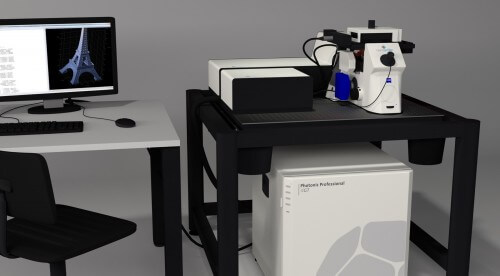Nanoscribe, the developer of the printer, was founded in 2007 in the scientific hothouse Karlsruhe Institute of Technology in Germany by scientists from the field of nanophotonics after about ten years of research

AVBA, the exclusive representative of Nanoscribe in Israel, will reveal for the first time as part of the "Nano-Israel 2014" conference and the accompanying exhibition, a XNUMXD nano printer based on the principle of writing in photoresist (a material sensitive to exposure to light) by a precise laser beam. The printer is able to "write" three-dimensional structures in high resolutions. Uses of the printer can be seen today in research in the field of micro-optics, photonics, materials research, medicine and in a variety of fields in the life sciences.
The printer makes it possible to print tiny three-dimensional structures, with a line thickness of several nanometers (for reference, the average thickness of a human hair is about 80,000 nanometers). The 'writing' is done on a physical principle of exposing light-sensitive material (a principle similar to photography using film). Unlike a camera, the exposure is done in this case by means of a thin laser beam that is directed with great precision onto the substrate and causes it to change its molecular structure. Through a simple process of removing the remnants of the unexposed material, a tiny structure is left according to the beam scanning plan. The development makes it possible to carry out what was until now defined as science fiction, such as printing nanometer robots, which are able to move in the human body and lead drugs to problem areas, or to study physical phenomena with a precision that was until now almost impossible.
The miniaturization obstacle is a known limitation in most fields of science and until now complicated processes were required to circumvent this technological limitation which required many working hours of development and experimentation. The new printer is an important technological accelerator whose influence can be seen in almost every field.
Nanoscribe was founded in 2007 in the scientific incubator Karlsruhe Institute of Technology in Germany by scientists from the field of nanophotonics after about ten years of research. Today, the nanometer printers are used in dozens of research centers around the world. The company recently won the prestigious innovation award Prism award 2014.
The first XNUMXD printer system in Israel was recently installed at the Hebrew University at the Broida Center for Innovation in Engineering and Computer Science.

3 תגובות
to Eran (who probably won't read this anymore),
First of all, your thought is very original and refreshing. It was interesting to think about it a bit, so with your permission I will add some perspective on the difficulties involved in implementing your idea.
First, you need to find a material that just happens to be in a remote location and will change its properties when exposed to light. The materials used here are complex materials. More specifically - organic materials. The material here is also kept in a state where it is not exposed to light (because otherwise it is not possible to control the change with the help of light). So you need the material to be sensitive to light of a certain wavelength, but not naturally exposed to it.
Now about the light. Diffused light. Even a focused laser beam can turn into a big spot pretty quickly. The spot size is your resolution. In addition, the energy density decreases as the spot grows. You can still build the largest structure in the universe, but you will need a huge starting energy.
To the question of moving a material by light - depends on the material, but somehow possible if the material is a dipole for example, just a little.
In short, good luck to us!
Maybe in another 100 million years there will be giant lenses spread across the galaxy focusing rays that will build homes on other stars in preparation for our arrival (:
Hey,
I'm writing here for the first time, I'm not from the field but I would appreciate a response 🙂
Is it conceptually possible to print a product by a light beam and attach material remotely?
Is it possible to push a nano material by light waves?
The idea is to create a situation where I print a nano-camera in another solar system and this will allow us to explore the same solar system remotely with nano-cameras and satellites.
Of course, the idea can be promoted to a million other things, but that's the idea in general.
Crazy I know...but is it scientifically possible?
Thanks
Is it suitable for the semiconductor industry? Because even they did not reach lithography at the level of a few nanometers... TOO GOOD TO BE TRUE